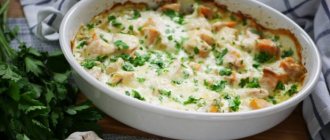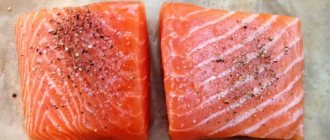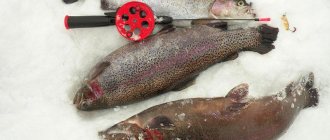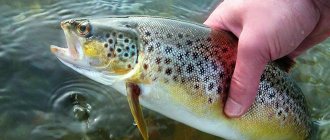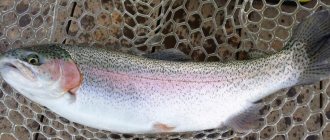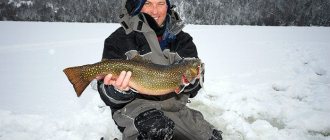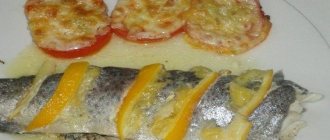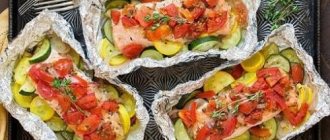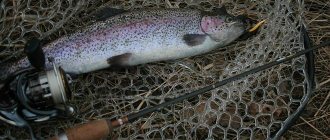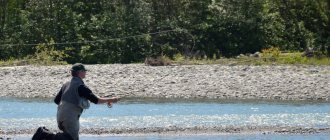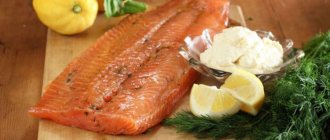River trout is the collective name for a number of fish of the salmon family. The habitat of this species is varied: it can be caught in many reservoirs of our country. The tender meat of this fish has found its wide application in cooking. Fillet can be boiled, baked, fried.
Which fish tastes better?
- Coho salmon 33%, 1553 votes
1553 votes 33%1553 votes - 33% of all votes
- Salmon 29%, 1387 votes
1387 votes 29%
1387 votes - 29% of all votes
- Trout 27%, 1260 votes
1260 votes 27%
1260 votes - 27% of all votes
- Chum salmon 8%, 394 votes
394 votes 8%
394 votes - 8% of all votes
- Pink salmon 3%, 123 votes
123 votes 3%
123 votes - 3% of all votes
Total votes: 4717
19.12.2019
×
You or from your IP have already voted.
Description
There are many species, subspecies, differing in habitat, size, color, and other characteristics. Some of these representatives belong to marine inhabitants (the marine one is the largest), and the main representatives live in fresh water bodies - ponds, lakes, rivers, streams with clean water. Trout cannot tolerate dirty waters, and in toxic conditions they quickly die.
Many species of trout have an average weight of 0.2-0.5 kg, a body length of about 30 cm. In favorable conditions, they grow up to 1 m in length and gain weight up to 2 kg. Marine species are larger than freshwater representatives, differ in the color of their meat and other characteristics. Migratory sea trout can gain weight up to 12 kg.
Freepik.com
Description of the characteristic features of the trout family:
- The body shape of all species is similar - slightly elongated and compressed at the sides, with a small head. The powerful, dense body looks like a spindle. The multitude of motley spots, the size and color of which depend on the species and habitat of the trout, make it especially decorative. This beauty is difficult to confuse with other fish.
- The scales are dense, small, rounded, covered with mucus. The color can be different, what color the trout is depends on the type of individual, habitat, and season. If the bottom of the reservoir is light, then its scales have a silvery tint. With a dark muddy bottom, its body also becomes darker. During spawning periods, the color changes - it becomes more vibrant and saturated. The size, shape, and color of the spots depend on the type of fish.
- All fins and tail are small and medium in size. There are 2 fins on the back - the first is the main regular fin, and the second (characteristic of all salmonids) is a fatty false fin, which is located closer to the tail.
- The muzzle is short and truncated. The teeth are strong and sharp and located on the vomer. Males differ from females in their smaller body size, larger head, and more teeth. Over time, an adult male develops a characteristic upward bend on the lower jaw, by which it is easy to distinguish him from a female.
- The eyes are small, light in color, almost transparent. Its vision is excellent - it easily navigates at any depth, vigilantly looks out for prey, and sees in many directions at the same time.
INTERESTING FACT: If this fish lives in salt water, then it absorbs food better, grows and gains weight faster than in fresh water. If fry of the same species are placed in several reservoirs with different habitat conditions, the color and size of the grown fish will differ noticeably.
Where does it live?
Brook trout loves cool places, so they try to stick to places where there are springs and the water temperature does not rise. It can stand behind various shelters on riffles, as well as in areas with slow currents: before or after them.
In summer, the predator prefers local pits with a slow flow under overhanging tree crowns or bushes.
The behavior of rainbow trout differs little from the lifestyle of brook trout. She likes to stand in the area of some kind of shelter. These could be large stones or driftwood at the bottom, or various uneven terrain. On sunny days, the fish is usually inactive, but with the onset of cloudy weather its behavior changes dramatically, and the predator becomes active.
Lake trout inhabits deep lakes, where they stay at depths of 50–100 meters. The fish may be at the bottom or moving through the water column. In summer, it often approaches the coastal zone.
A significant part of salmon species are distinguished by great plasticity and adaptability to external conditions. From the point of view of most ichthyologists, brown trout and all types of trout, except rainbow trout (mykiss), are one species, but in different ecological forms. In this case, brown trout are usually called a migratory form, and various sedentary ones are called trout. In this description, we will consider the marine, migratory form - brown trout. The maximum size of this fish can approach 50 kg. There are several subspecies, which can differ greatly in size and appearance.
Family
Of the seven genera of salmon representatives, three are species of the trout family:
- Atlantic. These include salmon species - Marble, Trout, Adriatic, Amudarya, Flathead, Ohrid, Sevan.
- Pacific salmon named Rainbow, Caucasian, Golden, Biva, Gila, etc.
- Loaches (Salmonidae). These include salmon - Lake, Silver, Bighead, Malma, Palia.
All of them are united under one common name “trout” based on genetic characteristics, external characteristics, size and other general characteristics.
pixabay.com
Distinctive features of the variegated species
Vladykov and Grachi 1771 believe that the uncertainty in the classification of the family. 5autoliae will disappear if you introduce new species: Patahuho Vĉadycov, Aaza sa&no Vaadycov w Rhαβdofατί ο Δορβ.
Rainbow trout are considered a freshwater form of Pacific steelhead. The most common type in our country. Many fish farms are engaged in its targeted breeding. This predator is stocked in paid ponds, where fishing with a spinning rod is especially popular.
Swims on the surface of the reservoir during the spawning period and is not afraid of people.
Trout are present in three of the seven genera of the family: salmon (Salmo), which includes Atlantic species; Pacific salmon (Oncorhynchus) and char (Salvelinus). Salmo ohridanus, Salmo ohridanus, also known as Belvica, is a species of freshwater salmonid fish endemic to Lake Ohrid in Albania and Macedonia.
Nutrition
Nutritional conditions differ on fish farms and natural reservoirs. In artificial growing conditions, special feed is used. In nature, juvenile wild trout feed on plankton, and as they grow older, large trout switch to other live food:
- insect larvae;
- small worms and shellfish;
- insects falling into water;
- crustaceans;
- small fish;
- tadpoles, frogs;
- caviar, larvae, fry of fish, even of their own species;
- adult fish even feed on small mammals that accidentally fall into the reservoir;
- also eats some types of plant foods.
INTERESTING FACT: Trout are very voracious. Such a fish eats half its weight in food per day. Adults eat fry of their own species even when there is enough food around.
Pexels.com
Trout farming
Ponds for artificial rearing of trout
For industrial purposes, for the food industry, trout can be artificially grown (reared) in ponds, cages on large reservoirs and fish farm basins, with suitable conditions for the habitat of this fish.
The supply of trout in large volumes is only possible in this way, since in nature this fish is caught only with a fishing rod and there can be no talk of a large number of fish caught.
The most suitable species for growing in limited space are rainbow and brook (river) trout.
Trout eggs can vary in size depending on the age of the individual.
Since it takes about one and a half years to obtain a marketable weight of 500 g, larger specimens, in artificial conditions, can only be found if they are raised as mother stock or for caviar production, which will be processed (salted) for sale.
A special place is occupied by obtaining trout caviar for food purposes. Due to the fact that this fish becomes sexually mature no earlier than after three years of life and the amount of caviar in one female is very small (from 1000 to 3000 eggs), the value of this product is much higher than that of other fish whose caviar (black and red ) is a delicacy product.
And a little about secrets...
Have you ever experienced unbearable joint pain? And you know firsthand what it is:
- inability to move easily and comfortably;
- discomfort when going up and down stairs;
- unpleasant crunching, clicking not of your own accord;
- pain during or after exercise;
- inflammation in the joints and swelling;
- causeless and sometimes unbearable aching pain in the joints...
Now answer the question: are you satisfied with this? Can such pain be tolerated? How much money have you already wasted on ineffective treatment? That's right - it's time to end this! Do you agree? That is why we decided to publish an exclusive interview with Professor Dikul, in which he revealed the secrets of getting rid of joint pain, arthritis and arthrosis.
Predator or not
Trout is a predatory fish; it comes out to hunt twice a day - in the morning at dawn and in the evening. Hunts mainly when it is cool and cloudy. In hot weather, it sinks to the very bottom, looking for prey in pools, whirlpools, and near waterfalls. When spring floods begin, it stays closer to the steep banks, where larvae and insects are washed out of the ground by fast currents. Adults hunt small fish, lying in wait and pouncing on prey. The predators themselves are difficult to notice; they hardly differ from the surrounding surface, because, like chameleons, they change their color, adapting to the features of the bottom of their reservoir. Apart from spawning periods, wild trout actively hunt for prey almost all year round.
Pixabay.com
What does it eat?
Trout is a predatory fish. At the beginning of life, its juveniles feed mainly on plankton, but as they grow older, they switch to a more varied diet, which consists of:
- small benthic invertebrates (molluscs and worms);
- crustaceans;
- larvae of semi-aquatic insects;
- frogs;
- beetles, butterflies, grasshoppers and other insects falling into the water;
- small fish.
Large individuals even attack small mammals that carelessly swim across a body of water. Trout can also eat plant foods. On many paid ponds it is caught using canned corn, dough, bread and others.
Spawning and offspring
When the time comes to spawn, the trout rises to the surface of the reservoir and begins to swim at high speed and splash. This is the time of mating games, after which females lay eggs with an average diameter of 4-6 mm. Each species spawns differently. Most of them reach maturity and begin to produce offspring at 3-4 years of age.
Pixabay.com
INTERESTING FACT: During spawning, trout are not afraid to swim close to the shore and boats.
Description of the features of spawning in nature:
- the lake spawns twice a year - in December-February and June-August, lays up to 1500 larvae at great depths of the reservoir, sometimes 100 m;
- freshwater brook trout spawn in November-December, laying from 200 to 5000 eggs on the rocky-pebble bottom of shallow water with a fast current;
- Rainbow spawns in March-April, laying up to 2000 eggs.
The larvae of the predator emerge from the eggs after 2 months, and then remain for a long time in their sacs, from which they feed on the simplest living organisms in the early stages, and then on larger zooplankton. In trout farms, the larvae feed on special feed. After 1.5 months, the fry emerge from their protective sacs and begin to quickly gain weight, feeding on the larvae of small insects. Over the course of a year, they reach a length of 12-15 cm.
Trout Spawning
Spawning of trout or brown trout, like many salmon, is not very fruitful, but very original. During spawning, trout's feeding activity decreases, but does not stop completely, as happens with Atlantic salmon or salmon. Trout spawns in rivers and streams, and enters them with a different state of reproductive products, depending on this, it spawns either in the year of entry or a year later. Like salmon or salmon, trout has spring and winter forms.
The spawning period for brown trout or trout is not clear and can be extended from September to February, depending on climatic and territorial conditions. Trout spawns in cold water at a water temperature of 4-8 ℃. Spawning in brown trout or trout occurs from 4 to 11 times during its life. This ability sharply distinguishes trout from salmon, since salmon or salmon are not capable of spawning multiple times except in rare cases.
Trout is ready to breed offspring in the fourth or fifth year of life. Spawning in trout is similar to the spawning of many salmon fish, such as the spawning of brook trout. Trout spawning occurs in shallow and rapid areas, both in the upper reaches of rivers and in the middle reaches; eggs are swept onto sandy and pebble soils or buried in holes. The spawned trout do not all go to sea; some migrate immediately into the sea in the same autumn, while some brown trout or trout overwinter in fresh water and migrate the following spring.
One adult female trout can lay 7-12 thousand eggs. The caviar is large, 5-6 mm in diameter, orange in color. The larvae hatch from the eggs after 6-8 weeks. The fry get a spotted coloration, and before going to sea the color changes. Typically, juveniles spend their first period of life in the river from one to seven years. Some males participate in breeding without ever having been to sea. The life cycle of sea and lake trout consists of five main periods, river, feeding in the lake or sea, breeding period, recovery period and death period.
Habitats
Many trout species and subspecies are found in fresh and salt water bodies on almost all continents. There are 57 species of brook trout in rivers around the world. Another representative, rainbow trout, lives not only in natural conditions, but is also bred in reservoirs for paid fishing and fish farms in many European countries. Norway is the leader in its breeding. This fish lives in rivers and lakes of Russia and Transcaucasia. Rainbow salmon is considered a freshwater species of Far Eastern Kamchatka salmon and American steelhead.
Trout is a cold-water fish; it does not tolerate heat and in such weather it goes to depths where it is cooler. The water for its habitat should only be clean, with a high oxygen content. In summer, in streams and rivers, it prefers to choose shaded places under the crowns of coastal trees, looking for local holes and slow currents. In rivers, the predator chooses mouths, areas under bridges, and rapids. It loves deep-water bodies of water; lake trout moves to a depth of 50-100 m. On sunny days it is inactive, and is most active in cool weather; it can reach speeds of up to 18 km per hour.
River trout, brook trout, and lake trout prefer permanent habitats, migrating only during spawning periods or when necessary to change the environment. And the sea fish is a migratory fish, capable of traveling long distances. Marine lives in the waters of the Pacific coasts of America and Asian countries, near the Atlantic shores of Europe, it can be found in the open ocean, and in other regions of the world where cool climatic conditions are suitable.
Pixabay.com
Variety of trout
Trout lives in the seas
, freshwater
lakes
, large
rivers
and small
streams
. Some species can change their habitats - lake trout, going to the river to spawn, leaves their offspring there, some of which may remain to live in the river, and some may return to the lake. The same thing can happen to sea trout that spawn in freshwater rivers.
Lake trout of the genus char
All trout species are classified into three main genera, which contain several varieties.
Loach genus:
Varieties of trout in nature
Dear visitors, save this article on social networks. We publish very useful articles that will help you in your business. Share! Click!
- lake;
- big-headed;
- silver;
- Dolly Varden;
- palia (American trout).
Genus of Pacific salmon
contains the following types of trout:
- Rainbow trout;
- Gila trout;
- Biwa sea trout;
- sea gold;
- Caucasian;
- Apache salmon.
To the genus of noble salmon
refers to trout:
- Sevan;
- marble;
- Ohrid;
- Amudarya;
- Adriatic;
- flathead;
- brown trout
Meat color
Many people are interested in whether trout is red or white fish. Both answers will be correct. Because different types of trout have different flesh color - it can be white, pink, yellowish, red, reddish orange. The marine representative has red meat, while the freshwater one has white or pink meat. Nutritional value and taste depend on its living conditions and nutritional characteristics. Since she always chooses clean waters, her meat is highly valued.
freepik.com
Kinds
Its representatives differ in their color, size, weight, habitat, prevalence and other features (see photo). The most common types of trout in Russia are:
- Ruchevaya. Freshwater fish that loves fast rivers and streams with clean, cool water. The body length is 25-55 cm, weighs on average up to 2 kg, but there are individuals up to 12 kg that are more than 10 years old. The color of brook trout ranges from yellow to dark brown, the back and head are dark, the belly is whitish. Throughout the body there are many dark or red spots with light yellow spots on the edges. Because of the way it looks, this fish is called a pestle. Depending on the habitat, the color can be lighter or darker, and the meat is white or pink, light orange.
- Ozernaya. Prefers deep lakes with cold water. Larger fish weigh more than stream fish, adult specimens reach a length of up to 1 m, and have a powerful body. The color of lake trout is silver, the belly is light, the back is dark. There are many dark spots throughout the body and fins. The intensity of the color depends on the habitat - in lakes with a light bottom the color of the fish is lighter, and if the bottom is dark, then the fish acquire more similar dark shades of scales.
- Rainbow. The most common type of freshwater trout in Russia, which is found in natural conditions and is bred in large numbers on fish farms. This species is native to the Pacific Basin from Alaska to Mexico. Subsequently, it was distributed to other continents for commercial purposes and sport fishing, and several domesticated subspecies were developed for farming. Rainbow, unlike other varieties, reproduces easily, grows faster, is hardy, unpretentious, and gets used to artificial nutrition. Therefore, it is grown on an industrial scale in many countries around the world. The color of the fish is silver with a light belly and a dark back from olive green to bluish. The entire body and fins are covered with small black specks. On the sides there are two bright pink stripes (as in the photo), from which the fish got its name.
Pexels.com
Appearance of trout
The overwhelming majority of trout representatives are small fish, with a body length of 25-30 cm and a weight of 200-500 grams.
The length of brook trout is about 30 cm
These parameters are valid mainly for brook (river) and rainbow trout, which are grown in ponds, cages and pools. Some specimens can grow much larger and gain weight up to 1 or 2 kilograms, but such fish can only be found in natural habitats for trout, that is, in the wild.
Different types of trout are colored differently, depending on the conditions in which they grew up. Individuals with a dark olive back with a greenish tint have a classic coloration. On the light sides with transverse stripes, small spots of dark red or black color are clearly visible (in some fish they are also surrounded by a light border). The abdomen is white with a hint of gray (sometimes copper-colored).
A variety of trout: they have differences in appearance due to the characteristics of their habitat
If we look at it as a whole, we can determine that one trout has predominant dark tones, while the other has predominant light tones. This depends on the food that the fish eats, the transparency and composition of the water of the reservoir in which it lives, the time of year and, in some cases, the color of the bottom. For example, in calcareous water, light silver specimens predominate, and if the bottom is covered with silt or is peaty, the color of the trout will be dark. If there is abundant food that is easily accessible to the fish, spots on its sides may be absent, and when the reservoir changes, they may disappear and appear along with the stripes.
Benefits and harms of consumption
Its meat is a low-calorie food product and has a rich composition of nutrients, vitamins, and minerals. This product is suitable for those who monitor their slim figure and health. There are only about 88 kcal per 100 g of product. Trout is recommended to be consumed for many diseases. Since it lives only in clean water, trout meat does not have harmful impurities. Dishes made from it are easily digestible without burdening the body. They contain many useful substances.
Highest content:
- iodine;
- phosphorus;
- zinc;
- B vitamins;
- Omega-3 and Omega-6;
- vitamins A, D and other useful components.
Freepik.com
Useful properties:
- normalizes metabolic processes;
- reduces cholesterol levels;
- strengthens blood vessels, arteries and heart;
- prevents the formation of blood clots;
- strengthens the nervous system;
- improves brain function;
- slows down the aging process thanks to its antioxidant properties;
- recommended for some forms of oncology, osteoporosis, diabetes;
- has a beneficial effect on the liver, immune, and digestive systems;
- improves the condition of skin, hair, nails;
- does not cause allergies, unlike most other fish, it is allowed to be eaten by allergy sufferers;
- Provides the body with important substances in an easily digestible form.
There are contraindications and reasons for limiting its use:
- some individuals, due to their habitat, may have a high mercury content, so this fish is not recommended for pregnancy, lactation and small children;
- this fish is fatty, so it is not recommended for diseases of the liver, gastrointestinal tract, ulcers;
- Trout caviar is not recommended for use in case of atherosclerosis, hypertension, or cardiac ischemia;
- Harmful substances can accumulate in the trout’s head, because some producers on their fish farms use growth hormones, antibiotics and other harmful additives to speed up the fish’s weight gain;
- Fish may contain parasites and their larvae, which may not be immediately detectable, so it is advisable to subject it to good cooking heat.
Fishing places and habitat
Trout lives in the river basins of the North Atlantic, Caspian and Black Seas. In the east, its range ends with the Czech Bay. The fish was actively settled in North and South America, in Australia and dozens of other places where people planned to fish for it. In rivers it can stay in different places. The general ecological features of behavior in the mainland reservoir are similar to other migratory salmon, but after entering the fresh water of rivers and lakes, unlike most salmon, they actively feed. Large individuals prefer to stay in depressions of the bottom, near the channel edge or near obstacles. Before spawning, it can accumulate near streams with spring water or near small spawning rivers.
Artificial breeding
In artificially created conditions, trout are raised on specially equipped fish farms, in open water bodies, and in small ponds. Fish need to be provided with all favorable conditions - clean, oxygenated water, its normal temperature (+14...+18°C), regular nutrition with nutritious food. And how much special equipment is required for the improvement of reservoirs - water purification systems, oxygen supply, incubators, feeders, etc. The arrangement of large open reservoirs requires especially significant expenditures of funds.
Pixabay.com
It is difficult to hunt this predatory fish because it is strong, agile, and fast. But this is a very exciting activity and the number of trout sport fishing enthusiasts is constantly increasing. Finding a body of water where it lives is not enough. You need to know the season and time of day when the best bite is, and use fishing gear correctly.
Trout is caught using a float or spinning rod, or fly fishing. The rod should be longer, with a rigid tip. The fishing line size is from 2 mm in diameter, hook numbers are suitable 6-8. Usually one hook is enough, but with a muddy bottom it is better to secure two at a distance of 20 cm. Spinner baits are chosen small, moving ones up to 10 cm long. For bait, use underleaf, dung worm, pieces of fish meat or its entrails.
pixabay.com
When fishing for trout, you should not make noise or fuss so as not to scare away the fish. All preparation of the equipment should be done away from the shore, fishing should begin unexpectedly - at this time, during the first casts, the largest trout are caught. If you startle her, she will no longer swim to the shore. Using a float rod, you fish vertically from the bottom, by rafting, with the bait sinking slowly. With a spinning rod they go upstream, the moving spoon attracts the attention of the fish. Trout bite confidently, so you need to hook and pull it out quickly. Large fish are caught using the usual methods.
INTERESTING FACT: Trout do not tolerate heat well and can fall into a coma in such conditions. If at this time it finds itself in shallow water, then it can easily be caught with your hands and the fish will not even try to swim away.
№2
They are carnivores and feed on many types of fish (including eels), insects, shellfish, shrimp, mayflies (an ancient order of winged insects), dragonflies, etc. But the diet of trout largely depends on the region in which it lives and its immediate size. Large fish feed mainly on large prey, while smaller species feed primarily on smaller prey.
It is included in the list of the most voracious fish. It feeds on large amounts of food throughout the year. Exceptions are spawning and periods when the water temperature rises above +20 degrees Celsius (then the fish goes into a coma).
In cooking
This fish is a gourmet and dietary product. It is easily digestible, rich in many beneficial substances, very tender and pleasant to the taste.
And how many delicious healthy dishes are prepared from trout:
- they make kebabs from it;
- salted;
- baked with nuts and vegetables;
- grilled;
- smoke;
- make fillings for pies;
- marinate;
- fry;
- make salads from raw fish;
- stuffed;
- cook soups, fish soup;
- steamed.

